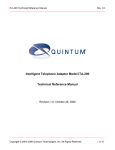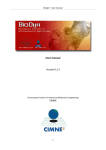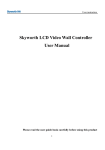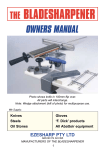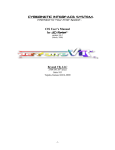Download ArtMesh User Manual
Transcript
ArtMesh User Manual 2015-11-20, corresponds to software version 3.4.557 1. About computer program ArtMesh performs quadrilateral and triangular surface meshing. Initial data for meshing is rough CAD-like triangular surface mesh. In other words, ArtMesh converts triangular facet into quadrilateral or refined triangular mesh. Some triangles usually exist in the mesh which is named quadrilateral here. So more correct name for such meshes is quad-dominant. ArtMesh program have two slightly different modes of work: - mode ART is used for visualization in computer graphics applications; - mode TECH is used for CAD-CAE applications (this version generates volume meshes but it is a work in progress). Initial state of program mode is defined at the stage of translation and is available in artmesh.dll properties (Properties>>Details>>”Product version”). Program mode can be changed at any time by using command “set preset” (section 4.3). Meshing software component artmesh.dll is built as dynamic link library (DLL). Information about version type (32 or 64 bit) is placed in artmesh.dll file properties (Properties>>Details>>”File description”). Trial versions of artmesh.dll has limited time of use that is specified in file Properties>>Details>>”Product version”. Console program artmesh_cmd.exe is used to launch artmesh.dll. Artmesh_cmd.exe uses text file (cmd.txt on default) with script-language commands. Import and export of meshes are performed via files. Description of file formats is placed in “ArtMesh file formats description” folder of documentation. ArtMesh supports 3 type of files for input/output: OBJ (Wavefront) VTK (ASCII only) STL (ASCII and binary) 2. How to start the program Files artmesh_cmd.exe and artmesh.dll must be placed in one folder. When artmesh_cmd.exe starts it tries to load artmesh.dll. The message with the result of DLL loading appears in console window. The work of the program is controlled by commands written in script language. There are three scenarios of program launch: 1. Place artmesh_cmd.exe and file cmd.txt in one folder. Text file cmd.txt must contain commands on script language. Start artmesh_cmd.exe. It will take commands from cmd.txt and execute them. 2. Start artmesh_cmd.exe with parameter that is the name of command file. Commands from this file will be executed. For example you can type in file manager “artmesh_cmd.exe cmd_file.txt”. Commands from cmd_file.txt will be executed. 3. Start artmesh_cmd.exe without command file. In this case commands may be typed in console window. Command "exit" (or "quit" or "q") is used to exit the program artmesh_cmd.exe. Command can be typed in console window or placed in the end of command file or used as the last parameter of program call. For example "artmesh_cmd.exe cmd.txt exit". Mesh Quality Hint Using of “hard” edges can significantly improve the mesh quality. You can define “hard” edges of your initial model and these edges WILL BE SAVED in mesh after conversion. Edges with sharp dihedral angle can be automatically marked as “hard” (look at ridge_angle parameter). Edges of model can be defined manually as “hard using file format features. Details are described in file “ArtMesh file formats (date,version).pdf”. 1 Now ArtMesh is not good for models with rounded bevels with small radius. Using sharp bevels instead of rounded or adding “hard” edges at the rounded bevels will make mesh better. 3. Commands meshing_file method=mname in=infile out=outfile h=lsize [use_subdivide=sub out_file_mode=fmode] Command performs mesh generation. Required parameters: metod Specifies the meshing method. metod=quad is used for quadrilateral meshing. metod=tri_orto is used for triangulation. Triangles are right-angled because this type of triangulation is the pre-stage for quadrilateral meshing. in Specifies the input file with triangular mesh. Quad mesh may be used too. Supported file formats: STL, OBJ, VTK. out Specifies the output file with generated mesh. Supported file formats: STL, OBJ, VTK. h Specifies the linear size of cells of generated mesh (average edge length). Optional parameters: use_subdivide Specifies the using of mesh subdividing. If use_subdivide=1 the subdividing of quad-dominant mesh is performed as the last stage of meshing. Triangles are subdivided in 3 quads; quads are subdivided in 4 quads. Almost all cells become quad when use_subdivide=1. The default value of use_subdivide is 0. out_file_mode Specifies the mode of the output file. If output file is STL then out_file_mode=binary specifies that file will be binary and out_file_mode=ascii specifies that file will be in ASCII form. The default value of out_file_mode is “binary”. Examples: meshing_file method=quad in=”cube.vtk” out=”cube 1.quad.vtk” h=3.5 use_subdivide=1 meshing_file method=tri_orto in=”cube.vtk” out=”cube.tri.vtk” h=3.5 dir path Sets current folder for input/output files. Example: dir "e:\tests" exec filename load filename Starts execution commands from file. Command load is executed in artmesh_cmd.exe, command exec is executed in artmesh.dll. Command load “understand” command exit, that ends work of program artmesh_cmd.exe. Command exec doesn’t “understand” command exit. exit quit q These commands stop application working. 4. Configuration parameters Configuration parameters are the global variables of program that can be changed by user. At program start these parameters are set to the defaults. Some parameters have acceptable range of values. New value must correspond to this range. Otherwise the new value will not be assigned to parameter. Syntax of assigning command: par_name=par_value 2 Example: dump_log=1 Spaces to the left and right of equality sign are not allowed. If parameter name is typed without the value the current value of parameter will be printed to console window. Command “set par_name default” assigns the default value to the parameter. Command “set default” assigns the default values to all parameters. Examples: dump_log - returns current value of dump_log. set dump_log default - assigns default value to parameter. set default - assigns default values to all parameters. 4.1 Meshing parameters ridge_angle This parameter controls identification of “sharp” edges of the model. It is the limit value for angles between normals of 2 cells adjacent to edge. If the angle is larger than this value the edge is considered to be “sharp”. By default the “sharp” edges become “hard” edges and they will be saved in generated mesh. Using of “hard” edges can significantly improve the mesh quality. Angle is set in degrees. Default value is 181. Such value means that no “sharp” edges will be identified. Such approach is good for organic models. If you work with hard surface objects it is necessary to determine “sharp” edges. You can use the value for example equal to 43. chords_per_circle Define the discrete approximation of curvature. Parameter sets the minimal number of lines (or edges) for full round at cylindrical part of surface (number of chords that describe circumference). The account of curvature is useful for meshing at conic and rounded parts of surfaces. If the initial surface has local singularities (jaggies, etc) the mesher can “think” that this is a region with large curvature and the mesh will be condensed at these places. It may be unexpected for user. So it is necessary to use this parameter carefully for low quality initial surfaces. If parameter is set to 0 the curvature is not taken into account. Default value is 8. aspect_ratio Parameter sets the limit value for ratio of edge lengths in cell. In some points of surface main curvatures can differs significantly and the linear sizes of mesh in curvature directions will be significant different too. Parameter aspect_ratio is used to avoid the appearance of too stretched cells. The maximum linear size in point will be reduced so the ratio of linear sizes will be close to aspect_ratio. Linear sizes ratio is controlled only when aspect_ratio is > 0. Default value is 3. ridge_angle_for_quad Parameter is used as a condition for joining two triangle cells into one quad cell. It is a maximal value of angles between normals of triangles that are adjacent to diagonal edge. Both diagonals of future quad are checked. If some angle exceeds ridge_angle_for_quad the quad cell formation is not allowed. This restriction is used for formation of quads and quad faces of hexahedrons, prisms and pyramids. Angle is set in degrees. Default value is 50. max_angle_for_quad Maximal value for interedge angle. Parameter is used as a condition for joining two triangle cells into one quad cell. If some interedge angle in hypothesized quad exceeds max_angle_for_quad the quad cell formation is not allowed. Angle is set in degrees. Default value is 172. angle_min_in_tri_for_point_insertion Parameter is used only for use_subdivide > 0 (argument of meshing_file command). If all interedge angles in triangular cell exceeds angle_min_in_tri_for_point_insertion the new node can be inserted in cell during the process of mesh subdividing. Otherwise node insertion is not allowed. This restriction is used to avoid the appearance of wedge like cells. Angle is set in degrees. Default value is 10. 3 skip_short_concave_ridge_edges_num Sets the number of consecutive concave “sharp” edges that will be excluded from the set of “hard” edges of initial geometry. Parameter takes effect only for isolated chains of “sharp” edges. This parameter is useful for models with accidental “sharp” edges at poorly refined models. Default value is 3. 4.2 Some additional parameters which might be useful for software integration dump_log Determine is the writing to log file will be performed. Log file’s default placement is artmesh_log\log.txt. This path is relative to the folder in which artmesh.dll is placed. Any command may be executed in silent mode (without writing echo to log file) using prefix ‘~’. For example ~dump_log=0 Value range: 0, 1. Default value is 1. file_in file_out Sets the input and output files for command meshing_file. Parameters “in” and “out” in command meshing_file may be omitted if filenames are defined using parameters file_in and file_out. Filenames set up in command meshing_file has higher priority than by parameters file_in and file_out. If output file is not defined its name is created by adding point and meshing method name to input filename without extension. Example: file_in=”cube_1.vtk” file_out=”cube_1 - q.vtk” meshing_file method=quad h=3.5 4.3 Parameter presets ArtMesh program have two slightly different modes of work: - mode ART is used for visualization in computer graphics applications; - mode TECH is used for CAD-CAE applications Initial state of mode is defined at the stage of translation and is available in artmesh.dll properties (Properties>>Details>>”Product version”). Program mode can be changed at any time by using command: set preset preset_name Two preset_names may be used: meshing_tech and meshing_art. In command files command “set preset” must be placed before commands that assign values to parameters that are changed by “set preset”, otherwise parameter values will be reassigned. Command “set preset” changes values of these parameters: Configuration parameters TECH ART ridge_angle 36 181 ridge_angle_for_quad 27 50 max_angle_for_quad 160 172 angle_min_in_tri_for_point_insertion 25 10 default value of h_ratio in meshing_file command 0.45 -1.0 5. Some technical details for software integration When artmesh.dll performs meshing a temporary file artmesh_instance_id_[0001] is created in the directory where artmesh.dll is placed. The number in filename corresponds to the number of artmesh.dll instance running 4 on a computer. First DLL instance creates file artmesh_instance_id_[0001], second – file artmesh_instance_id_[0002] and so on. These files are automatically deleted when artmesh.dll instance stops running. Meshing progress information is written to these files. Example: meshing progress (stage/ms/%): 7 27124 71.065 First numerical column is the stage of meshing (it is internal stage that is not important to user), second column is time of meshing in milliseconds, third column – percentage of meshing progress. When meshing is finished the word “done” will be written to file: meshing progress: done Data exchange between calling program and artmesh.dll can be carried out using RAM. In this case a set of external functions of artmesh.dll is used. This possibility is not described in this manual but can be implemented on demand. 6. Copyright and disclaimer ArtMesh Software is free for personal usage. ArtMesh Software is provided “as is”, without any guarantee made as to its suitability or fitness for any particular use. It may contain bugs, so the use of this tool is at your own risk. We take no responsibility for any damage that may unintentionally be caused through its use. You may not distribute ArtMesh Software in any form without our permission. Send your comments, questions and suggestions at [email protected]. Copyright © 2015 5





